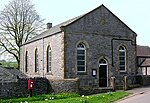Cromford and High Peak Railway
British companies established in 1825Closed railway lines in the East MidlandsEarly British railway companiesHorse-drawn railwaysLondon and North Western Railway ... and 8 more
Peak DistrictPortage railwaysRail transport in DerbyshireRailway companies disestablished in 1887Railway companies established in 1825Railway inclines in the United KingdomRailway lines opened in 1831Use British English from November 2017

The Cromford and High Peak Railway (C&HPR) was a standard-gauge line between the Cromford Canal wharf at High Peak Junction and the Peak Forest Canal at Whaley Bridge. The railway, which was completed in 1831, was built to carry minerals and goods through the hilly rural terrain of the Peak District within Derbyshire, England. The route was marked by a number of roped worked inclines. Due to falling traffic, the entire railway was closed by 1967. The remains of the line, between Dowlow and Cromford, has now become the High Peak Trail, a route on the National Cycle Network.
Excerpt from the Wikipedia article Cromford and High Peak Railway (License: CC BY-SA 3.0, Authors, Images).Cromford and High Peak Railway
Derbyshire Dales Hartington Middle Quarter CP
Geographical coordinates (GPS) Address Nearby Places Show on map
Geographical coordinates (GPS)
| Latitude | Longitude |
|---|---|
| N 53.1824 ° | E -1.8065 ° |
Address
SK17 9QJ Derbyshire Dales, Hartington Middle Quarter CP
England, United Kingdom
Open on Google Maps










